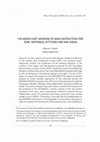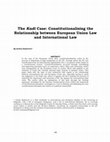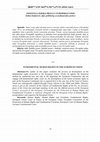Books by Andrej Stefanovic
Konrad-Adenauer-Stiftung e.V.
Papers by Andrej Stefanovic
Peace Review, 2024
The paper aims to review the perceptions of the Southeast European countries toward the NPT and T... more The paper aims to review the perceptions of the Southeast European countries toward the NPT and TPNW and identify the main determinants of their disarmament policies. It analyzes official statements of the Southeast European states during the NPT preparatory meetings and review conferences, and their positions in various stages of the TPNW development, to bring out a position of a certain country toward the NPT and TPNW and then dive into analysis of the determinants of the outcomes. The paper contributes to the deeper understanding of the disarmament policy choices of the Southeast European states, thus also contributing to the assessment of possible changes in their positions regarding the nuclear weapons ban.

Convergence and Confrontation: The Balkans and the Middle East in the 21st Century, 2021
The 2021 events, such as the Tenth Review Conference (RevCon) of the Nuclear Non-Proliferation Tr... more The 2021 events, such as the Tenth Review Conference (RevCon) of the Nuclear Non-Proliferation Treaty (NPT), the renewed Israeli-Palestinian conflict, the confirmed use of chemical weapons in the conflicts in the region, and the frequent proposals for the new Biden administration to return to the jCPoa, raised the issue of the Middle East weapons of Mass Destruction Free Zone (MEwMDFZ) establishment high on the contemporary international agenda once again. The aim of this paper is to assess the prospects of the MEwMDFZ through the historical analysis of similar models, exploration of the rationale behind the MENwFZ/wMDFZ proposal since 1974 and its development through the subsequent decades, attitudes of key stakeholders, and the possible way ahead. The authors employ historical analysis to present the evolution of the proposal on the MEwMDFZ, content analysis of the documents adopted on this issue, and a comparative method to present the key stakeholders' points of contention and draw conclusions from similar models such as NwFZs. The authors conclude that the establishment of the MEwMDs will remain a "moving target," but one that is necessary in order to maintain the momentum of the peace process, the credibility of

Politika nacionalne bezbednosti, 2021
Did the Biden administration pick up at least some of the pieces of the broken liberal internatio... more Did the Biden administration pick up at least some of the pieces of the broken liberal international order caused in some part by his predecessor Trump? Has he been acting according to his and his party’s promises during the presidential-elections campaign or has he stood by his predecessor’s decisions? And especially how much was done or “repaired” in the realm of arms control? These are the questions authors will try to answer in this paper. They will draw their conclusion by analyzing theoretical assumptions that lie behind the Trump’s and Biden’s approach toward the international institutions, including arms control, historical analysis of Trump’s legacy regarding international institutions, content analysis of Biden’s and Democratic Party’s promises and their comparison with the Republican attitudes. In assessing how much was done in the first year of Biden’s mandate in the realm of arms control, authors conclude that the results are mixed – in some cases Biden followed Trump’s...
Journal of Liberty and International Affairs, 2017
The author of this article uses the comparative method in describing how judicial bodies through ... more The author of this article uses the comparative method in describing how judicial bodies through their case law shaped and modeled the federal structures of government in the cases of the United States and the European Union. Through initially laying out the theoretical explanations of the significance of constitutional (judicial) review in federal structures, and elaborating on the powers and position of the Supreme Court in the United States and the Court of Justice in the European Union, he seeks to show how these bodies influenced, in similar ways, some of the key features of these two federal organizations.
Epiphany, 2016
This paper deals with the process of constitutional reform in Serbia in the context of European i... more This paper deals with the process of constitutional reform in Serbia in the context of European integration. Serbia has officially started the negotiations process for European Union membership, something which will require Serbia to conduct fundamental changes to its legal, economic and political system. Changes will also have to be introduced to Serbia's Constitution. These changes, ultimately, will lead to the Europeanization of Serbian constitutional law and should enable this country's smooth and transparent transition towards membership in the Union.
Journal of Regional Security, 2021
The author explores the deterioration and (forthcoming) collapse of the global arms control syste... more The author explores the deterioration and (forthcoming) collapse of the global arms control system, with special consideration given to potential consequences this event would have for the European continent. In this context, and in assessing the significance of the remaining mechanisms for preventing a potential arms race and deepening of conflict in Europe, he draws attention to the OSCE Vienna Document as a tool that could enable the revival of stability through confidence-building in Europe, especially given its capacity for adaptation and modernization.
Perspektive Evropske unije, 2012

Politika nacionalne bezbednosti, 2021
Did the Biden administration pick up at least some of the pieces of the broken liberal internatio... more Did the Biden administration pick up at least some of the pieces of the broken liberal international order caused in some part by his predecessor Trump? Has he been acting according to his and his party’s promises during the presidential-elections campaign or has he stood by his predecessor’s decisions? And especially how much was done or “repaired” in the realm of arms control? These are the questions authors will try to answer in this paper. They will draw their conclusion by analyzing theoretical assumptions that lie behind the Trump’s and Biden’s approach toward the international institutions, including arms control, historical analysis of Trump’s legacy regarding international institutions, content analysis of Biden’s and Democratic Party’s promises and their comparison with the Republican attitudes. In assessing how much was done in the first year of Biden’s mandate in the realm of arms control, authors conclude that the results are mixed – in some cases Biden followed Trump’s decisions and in some other he completely changed the approach.
Evropska unija i evropske integracije Republike Srbije, 2019
The author discusses and critically assesses the current situation and
challenges in Serbia’s Eur... more The author discusses and critically assesses the current situation and
challenges in Serbia’s European Union accession process regarding
Chapter 31, i.e. the obligation of aligning foreign policy with the EU.
This is put into a wider context of the (non) existence of Serbia’s foreign
policy strategy and the necessity of fulfilling different, often diverse and
even competing foreign policy objectives.
Studentski godišnjak Fakulteta političkih nauka, 2016
Ovaj rad nastoji da ukaže na presudnu ulogu Suda pravde Evropske unije u konstitucionalizaciji i ... more Ovaj rad nastoji da ukaže na presudnu ulogu Suda pravde Evropske unije u konstitucionalizaciji i federalizaciji Evropske unije, odnosno njenog pravnog i političkog sistema, čime Evropska unija danas sve više liči na konstitucionalne i (kvazi)federalne sisteme. Autor nastoji da objasni na koji način je Sud pravde u svojoj praksi doveo do stvaranja nekih od najznačajnijih načela na kojima se zasniva pravo Unije i koji su, u krajnjoj liniji, doveli do uobličenja ustavne arhitekture Unije.

International Journal of Rule of Law, Transitional Justice and Human Rights, 2016
In the case of the European Union (EU), constitutionalisation refers to the process of deepening ... more In the case of the European Union (EU), constitutionalisation refers to the process of deepening of legal integration in the EU, through which the EU was transformed from an international organisation into a sui generis entity based on a 'constitutional charter'. Constitutionalisation occurred through crystallising and approving principles such as supremacy, direct effect and autonomy, which were inaugurated by the European Court of Justice (ECJ) and applied to the relations of Union law towards national legal systems of member states. This paper deals with the topic of new tendencies with regard to the relationship between international law and European Union law, especially having in mind the judgment in the Kadi case, where it appears the ECJ initiated the process of asserting the supremacy and autonomy of EU law against the international legal order. The author offers an explanation of this shift through the Solange argument, developed by the German Constitutional Court within the framework of constitutional pluralism, envisaged as a tool in defining and defending the core constitutional principles and values of a political community.
Journal of Liberty and International Relations , 2017
The author of this article uses the comparative method in describing how judicial bodies through ... more The author of this article uses the comparative method in describing how judicial bodies through their case law shaped and modeled the federal structures of government in the cases of the United States and the European Union. Through initially laying out the theoretical explanations of the significance of constitutional (judicial) review in federal structures, and elaborating on the powers and position of the Supreme Court in the United States and the Court of Justice in the European Union, he seeks to show how these bodies influenced, in similar ways, some of the key features of these two federal organizations.
This paper deals with the process of constitutional reform in Serbia in the context of European i... more This paper deals with the process of constitutional reform in Serbia in the context of European integration. Serbia has officially started the negotiations process for European Union membership, something which will require Serbia to conduct fundamental changes to its legal, economic and political system. Changes will also have to be introduced to Serbia’s Constitution. These changes, ultimately, will lead to the Europeanization of Serbian constitutional law and should enable this country’s smooth and transparent transition towards membership in the Union.

This paper seeks to shed further light on the issue of citing and referring to foreign law in the... more This paper seeks to shed further light on the issue of citing and referring to foreign law in the United States Supreme Court, especially in cases surrounding the expansion of human and constitutional rights. Therefore, the author introduces the reader to the origins and most important features of the human rights system in the American constitutional and legal system. Likewise, he points to the issue of conflicts between different kinds of methods of constitutional interpretation, a debate especially controversial and difficult in American constitutional adjudication. Likewise, the author looks back to the issue of relationship between the American domestic legal system and international law, as a part of the controversy surrounding this debate. Last part of the article is dedicated to examining most important cases in this domain, which are mostly with regard to the VIII and XIV Amendments of the US Constitution.

Naučno-stručni časopis o evropskim integracijama "Sui Generis", Year 3, Vol. 3, Sep 2016
This paper explores the subject of the accession of the European Union to the European Convention... more This paper explores the subject of the accession of the European Union to the European Convention for the Protection of Human Rights and Fundamental Freedoms (ECHR). The long standing academic and practical discussion on the subject and the fact that an Accession Agreement has been drafted, entail the need for establishing certain conclusions with regard to interaction of fundamental rights system of the EU and the ECHR, as well as the place of the ECHR in the EU’s legal order, both in the pre-accession and the post-accession context. In order to thoroughly analyse the whole process, the author begins with examining the very nature and development of human rights law within the EU and the role the ECHR has had so far in shaping of this legal order. Furthermore, the author endeavours to assess all of these developments with regard to the principles of autonomy and supremacy of EU law.

The author of this paper examines the process of development of the
fundamental rights protection... more The author of this paper examines the process of development of the
fundamental rights protection in the European Union. Firstly, he applies the historical method by explaining how and why in the beginning the European Communities did not engage with fundamental rights. Later on, the development of the notion of human rights as part of the European Community law is exposed first in the case law of the Court of Justice, which was subsequently codified through Treaty reforms in the 1990s and 2000s. Likewise, stress is put on the research of the Charter of Fundamental Rights of the EU, its structure, place in the Union law and legal standing. In the end, the difficult process of the European Union’s accession to the European Convention for the Protection of Human Rights and Fundamental Freedoms is explored, alongside with the European Court of Human Rights’ jurisprudence with regard to the European Union.
“Europe has never been so prosperous, so secure nor so free”
- A Secure Europe in a better World,... more “Europe has never been so prosperous, so secure nor so free”
- A Secure Europe in a better World, the European Security Strategy from
2003
Affairs in which it was possible to write down such words seem worlds away from the situation we live in today, when the very concept of the European Union is challenged and put to a test...
Unlike the 2003 Strategy, the Global Strategy for the EU’s Foreign and Security Policy, made public in June 2016, starts with the following words: “We live in times of existential crisis, within and beyond the European Union. Our Union is under threat. Our European project, which has brought unprecedented peace, prosperity and democracy, is being questioned…”.

Apstrakt: Vrhovni sud predstavlja jednu od tri najznačajnije savezne institucije u SAD, uz Predse... more Apstrakt: Vrhovni sud predstavlja jednu od tri najznačajnije savezne institucije u SAD, uz Predsednika i Kongres. On se danas ubraja među najznačajnije pravosudne institucije na svetu, s obzirom na značajna ovlašćenja koja ima u pogledu kontrole ustavnosti i zakonitosti akata kako federalnih jedinica, tako i federalne, odnosno centralne vlade. Iako se u vreme usvajanja Ustava SAD 1787. godine nije mnogo značaja pridavalo ovoj instituciji, Vrhovni sud je kroz primenu precedentnog prava uspeo da se profiliše u instituciju koja deluje ne samo kao poslednja sudska instanca, već kao ravnopravni element u američkom sistemu podele vlasti, stvarajući kontra-ravnotežu kako Predsedniku, tako i Kongresu, ali i vlastima američkih država. Osim toga, Vrhovni sud je postao značajan i kao ustanova koja je bila branilac građanskih prava i sloboda u SAD, nastojeći da ostvari potpunu pravnu jednakost kroz XIV amandman, pre svega što se tiče afro-američke populacije u SAD. Na kraju, Vrhovni sud ima ulogu i u procesu ekspanzije federalne vlasti kroz elastično tumačenje odredbe o osnovama nadležnosti Kongresa, sadržane u članu 1, odseku 8 Ustava SAD. Ukratko, da bi se razumeo Ustav SAD neophodno je prodreti dublje u sudsku praksu Vrhovnog suda, jer, kako navode i pravnici ali i društveni komentatori, postoji razlika između Ustava napisanog pre više od dva veka, i onog ustava koji se danas primenjuje i koji se nalazi ne samo u ovom dokumentu, već i u presudama Vrhovnog suda, kao i u mnogim nepisanim pravilima i običajima. Ključne reči: Vrhovni sud, ustavni sud, ustavni sistem, politički sistem, podela vlasti, federalizam, sudska revizija, ocena ustavnosti, ljudska prava Abstract:The Supreme Court counts among the three most important federal institutions in the United States of America, alongside the Congress and the President. Likewise, the Supreme Court belongs to a group of most important and influential judicial institutions around the world, considering its broad competences in constitutional review not only of state acts, but also federal legislation. Even though there was little attention paid to the Supreme Court in the time when the Constitution was drafted in 1787, however it managed to emerge into an institution that not only acts as a judicial forum of last resort, but also as an equal element in the American system of checks and balances, balancing the powers of the other two federal institutions, as well as the powers of federal units. Besides this, the Supreme Court can be viewed as a defender of civil rights and liberties in the US, as it used the XIV Amendment in securing the full implementation of equality before the law, and the first important step was made with regard to the African-American population and in the last few years with regard the LGBT population. Last, but not least, the Supreme Court was important in expanding federal powers through applying an elastic interpretation of the Congress's competences, outlined in Article 1, Section 8 of the US Constitution. In other words, the best way of making sense of the US Constitution is to study the case law of the Supreme Court, considering that there is a striking difference between the Constitution 61 Fakultet političkih nauka, andrejstef89@gmail.com

Ujedinjeno Kraljevstvo je nastajalo u periodu od XII do XIX veka. Englesko kraljevstvo, koje je u... more Ujedinjeno Kraljevstvo je nastajalo u periodu od XII do XIX veka. Englesko kraljevstvo, koje je ujedinjeno u X veku, najpre je i najlakše pokorilo Vels i to u XII veku. Vels je još od XVI veka bio smatran integralnim delom Engleske i zato su se zakoni koji su donošeni u Parlamentu Engleske podjednako odnosili i na Englesku i na Vels. S druge strane, Škotska i Irska nisu tako lako pale pod vlast engleske Krune. Između Engleske i Škotske nije bilo toliko neprijateljstva do XIV veka. Tada na scenu stupa kralj Edvard koji je kroz nekoliko ratnih operacija nastojao da osvoji Škotsku. U tome nije uspeo i zato je 1328. godine potpisan Sporazum iz Edinburga kojim je Engleska priznala postojanje Škotske kao nezavisne nacije. Međutim, 1603. godine dolazi do ujedinjenja engleske i škotske krune, pa vek kasnije i do ujedinjenja engleskog i škotskog parlamenta (1707). Time nastaje prva od dve političke unije na britanskom ostrvu. Ova prva unija dobila je naziv Velika Britanija. Iako je ova unija bila formalno unija jednakih, u stvarnosti to nije bio slučaj. Engleska je bila snažniji partner u uniji i to je navelo mnoge da tvrde da bi do stvaranja politčke unije došlo nasilnim putem, da nije moglo mirnim sredstvima. Kao što je i Henri VIII, engleski kralj iz XVI veka, predvideo-" jači je privukao slabijeg " 1. Ovaj period između 1603. i 1707. je veoma značajan u ustavnoj istoriji Engleske, pa, naravno, i celog Ujedinjenog Kraljevstva, jer je prošao u znaku borbe Krune i Parlamenta za prevlast, kao i donošenja nekoliko značajnih ustavnih akata koji predstavljaju osnovu političkog i ustavnog











Uploads
Books by Andrej Stefanovic
Papers by Andrej Stefanovic
challenges in Serbia’s European Union accession process regarding
Chapter 31, i.e. the obligation of aligning foreign policy with the EU.
This is put into a wider context of the (non) existence of Serbia’s foreign
policy strategy and the necessity of fulfilling different, often diverse and
even competing foreign policy objectives.
fundamental rights protection in the European Union. Firstly, he applies the historical method by explaining how and why in the beginning the European Communities did not engage with fundamental rights. Later on, the development of the notion of human rights as part of the European Community law is exposed first in the case law of the Court of Justice, which was subsequently codified through Treaty reforms in the 1990s and 2000s. Likewise, stress is put on the research of the Charter of Fundamental Rights of the EU, its structure, place in the Union law and legal standing. In the end, the difficult process of the European Union’s accession to the European Convention for the Protection of Human Rights and Fundamental Freedoms is explored, alongside with the European Court of Human Rights’ jurisprudence with regard to the European Union.
- A Secure Europe in a better World, the European Security Strategy from
2003
Affairs in which it was possible to write down such words seem worlds away from the situation we live in today, when the very concept of the European Union is challenged and put to a test...
Unlike the 2003 Strategy, the Global Strategy for the EU’s Foreign and Security Policy, made public in June 2016, starts with the following words: “We live in times of existential crisis, within and beyond the European Union. Our Union is under threat. Our European project, which has brought unprecedented peace, prosperity and democracy, is being questioned…”.
challenges in Serbia’s European Union accession process regarding
Chapter 31, i.e. the obligation of aligning foreign policy with the EU.
This is put into a wider context of the (non) existence of Serbia’s foreign
policy strategy and the necessity of fulfilling different, often diverse and
even competing foreign policy objectives.
fundamental rights protection in the European Union. Firstly, he applies the historical method by explaining how and why in the beginning the European Communities did not engage with fundamental rights. Later on, the development of the notion of human rights as part of the European Community law is exposed first in the case law of the Court of Justice, which was subsequently codified through Treaty reforms in the 1990s and 2000s. Likewise, stress is put on the research of the Charter of Fundamental Rights of the EU, its structure, place in the Union law and legal standing. In the end, the difficult process of the European Union’s accession to the European Convention for the Protection of Human Rights and Fundamental Freedoms is explored, alongside with the European Court of Human Rights’ jurisprudence with regard to the European Union.
- A Secure Europe in a better World, the European Security Strategy from
2003
Affairs in which it was possible to write down such words seem worlds away from the situation we live in today, when the very concept of the European Union is challenged and put to a test...
Unlike the 2003 Strategy, the Global Strategy for the EU’s Foreign and Security Policy, made public in June 2016, starts with the following words: “We live in times of existential crisis, within and beyond the European Union. Our Union is under threat. Our European project, which has brought unprecedented peace, prosperity and democracy, is being questioned…”.